Cao Z. (Ed.) Thin Film Growth: Physics, materials science and applications
Подождите немного. Документ загружается.

298 Thin film growth
© Woodhead Publishing Limited, 2011
as sample quality is concerned, the AlN layer formed at low temperature is
homogeneous and smooth, which acts as a high quality template and results
in a less defective and smooth buffer gan layer, leading to high quality gan
lm. On the other hand, the AlN layer formed at high temperature is rough
and inhomogeneous, which leads to a defective GaN buffer layer including
inversion domains, resulting in low quality GaN lm.
it should be noted that the aln formed by nitridation is mainly n-polarity.
On this N-polar AlN ultra-thin layer, GaN buffer layer grown at 600°C has
been proved to be mainly N-polarity (90%) by in-situ CaiCiss measurement
independent of the III/V ratios. This means that with Ga-rich growth or even
Ga bilayer, it is difcult to invert the polarity. However, the behavior of the
aln layer is different from that of gan. it has been found that the polarity
of AlN layer grown at low temperature depends critically on both the surface
stoichiometry in the initial growth stage and during epitaxy. The N-polar
AlN buffer or epitaxial layer has been grown under N-rich conditions while
the Al-polar buffer has been obtained under Al-rich growth conditions. The
N-polar AlN layer even changes to Al-polar after the growth conditions
change from N-rich to Al-rich as shown in Fig. 12.8(a). Even at the high
temperature (820°C) growth of AlN, the polarity of AlN is inverted from
N-polarity to Al-polarity by changing the growth conditions from N-rich to
al-rich. This polarity inversion is due to the formation of al bilayer in the
Al-rich growth condition as shown in Fig. 12.8(b). In the case of Ga-rich
growth for GaN epitaxy, Ga bilayer is also easily formed. However, it is
also easily broken by the strike of n atoms. The al bilayer is different. once
the Al bilayer is formed, it is more difcult to break than the Ga bilayer
and results in Al-polarity. This is also conrmed by the polarity inversion
of GaN through an insertion of Al bilayer. Figure 12.9 shows the polarity
dependence of GaN and AlN on growth conditions. The original polarity
of GaN is not inuenced by Ga/N ratios while that of AlN is maintained in
N-rich growth conditions. Al-polar AlN is usually obtained in Al-rich growth
conditions. so in the case of gan epitaxy, n-polarity is easily obtained by
using low temperature GaN buffer layer while Ga-polarity is achieved by
using AlN buffer layer grown under Al-rich conditions.
The growth behavior and properties of GaN in different polarities differ
largely. Growth is usually performed under Ga-rich conditions to improve
sample quality, which is independent of polarity. However, the Ga-bilayer
always remains at the growth front for Ga-polarity while a single Ga atom
layer exists on the top surface during epitaxy of n-polarity. The ga-polar
GaN usually shows better crystal quality and smoother surface than that of
N-polar GaN. The surface of Ga-polar GaN is essentially featureless between
steps while the N-polar surface exhibits an island structure. The Ga-polar
gan surface is more stable than that of the n-polar one in vacuum. The
growth rate of Ga-polar GaN is sometime higher than that of the N-polar one,
ThinFilm-Zexian-12.indd 298 7/1/11 9:44:16 AM
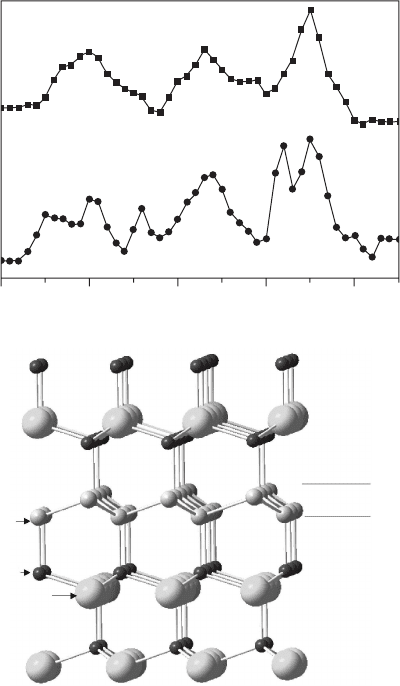
299Polarity controlled epitaxy of III-nitrides and ZnO
© Woodhead Publishing Limited, 2011
which is one of the reasons for the formation of pits with inversion domains.
The impurity incorporation and doping efciency are also inuenced by
the polarity. P-type doping using Mg is much easier on the ga-polar gan
than on that of the n-polar one. Li et al. (2000) reported that the p-type
conductivity with a free-hole concentration up to 5 ¥ 10
17
cm
–3
was realized
on Ga-polar GaN while N-polar GaN was highly resistive or semi-insulating.
In the case of n-type doping, Ng and Cho (2002) found that there was no
signicant difference for the incorporation of Si into GaN of either polarity.
However, the background impurities such as C and O were found to be more
Signal intensity of AI (a.u.)
AIN epilayer grown in Al-rich condition
AIN epilayer grown in N-rich condition
0 20 40 60 80
Incident angle q (deg)
(a)
Al
N
Ga
Ga-polarity
2ML-Al
N-polarity
(b)
12.8 (a) CAICISS spectrum of N-polar AlN epilayer grown in N-rich
conditions, and the spectrum of AlN epilayer after the growth
condition is switched to Al-rich. The thickness of an AlN layer grown
in Al-rich conditions is about 30 nm. (b) The schematic atomic
structure of polarity inversion by an Al bilayer.
ThinFilm-Zexian-12.indd 299 7/1/11 9:44:16 AM
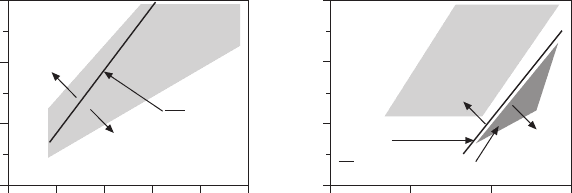
300 Thin film growth
© Woodhead Publishing Limited, 2011
easily incorporated into n-polar gan. sumiya et al. (2000) also reported
that the impurities related to C, O and Al were more readily incorporated
into N-polar GaN lm. Oxygen was incorporated at a rate ten times faster
into the n-polar gan than into the ga-polar gan, as reported by Park et al.
(2001). The effect of polarity on the AlN layer is very similar to that on the
gan.
12.5 Polarity controlled epitaxy of InN
InN epitaxy is the most difcult among the III-nitrides, and the effect of
polarity on it is more serious than on gan and aln. This is mainly because
the dissociation temperature of InN is very low, much lower than the re-
evaporation temperature of in metal. one of the most obvious effects of polarity
on InN epitaxy is the maximum epitaxy temperature (Xu and Yoshikawa,
2003). As shown in Fig. 12.10, the maximum epitaxy temperature is about
600°C for N-polarity, which is about 100°C higher than for In-polarity.
above these temperatures, inn epilayers start to decompose and in droplets
appear on the surface. once those in droplets appear on the surface, they
do not re-evaporate and the only way to remove them is nitrogen radical
irradiation. It means that the growth process is limited by the dissociation
of inn itself but not by the re-evaporation of excess in on the surface. This
is different from the other III-nitrides such as GaN. The growth regimes are
also different between InN and GaN. As shown in Fig. 12.11, there are two
regimes for inn, i.e. in-rich and n-rich regimes. Under in-rich regimes, there
is no way to avoid the formation of In droplets. Under N-rich regimes, the
surface is rough and the quality is not good. The two growth regimes of InN
epitaxy are different from those of GaN, where three growth regimes exist,
i.e. ga-rich, intermediate (ga-rich but free of ga droplets) and n-rich.
The growth mode and surface morphology are also greatly affected by
polarity. Step-ow growth mode is obtained in the In-polarity growth regime
N rich
N rich
Al rich
Ga rich
Ga
= 1
N
Al
= 1
N
Original
polarity
Original
polarity
P
N2
(10
–6
torr)
P
N2
(10
–6
torr)
8
6
4
2
8
6
4
2
0.0 0.5 1.0 1.5 2.0 2.5
Ga flux (Å/s)
0.00 0.25 0.50 0.75
Al flux (Å/s)
Al-polarity
12.9 Schematic diagrams showing effect of surface stoichiometry on
polarity control processes of (a) GaN and (b) AlN in MbE growth.
(a) (b)
ThinFilm-Zexian-12.indd 300 7/1/11 9:44:17 AM
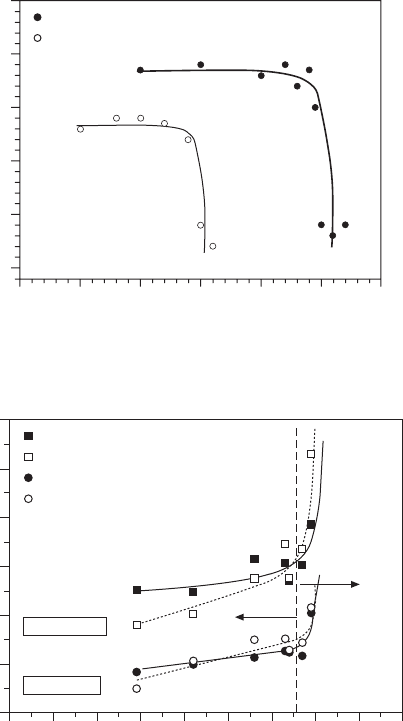
301Polarity controlled epitaxy of III-nitrides and ZnO
© Woodhead Publishing Limited, 2011
but not in the n-polarity regime (Wang et al., 2006). Figure 12.12 shows the
typical surface morphology of InN with In- and N-polarities, respectively.
An atomically at surface with a step and terrace feature formed in step-ow
growth mode can be observed for In-polar InN. The step height is 0.28–0.29
nm, which coincides with 1/2 of the c lattice constant of InN, showing that
the step height is a single monolayer. The surface roughness is 0.9 nm in
N polarity
In polarity
350 400 450 500 550 600 650
Substrate temperature (°C)
InN growth rate (Å)
2.5
2.0
1.5
1.0
0.5
0.0
12.10 Growth rate of InN films with different polarities as a function
of growth temperature.
<e
1
> or <e
2
>
12
10
8
6
4
2
0
l = 700nm
N-polarity
3 4 5 6 7 8 9 10 11 12
beam pressure of Indium (E-7 toor)
N-rich
In-rich
<e
1
> of InN
Convergent point of <e
1
>
<e
2
> of InN
Convergent point of <e
2
>
12.11 Growth regime diagram illustrated by <e
1
> and <e
2
> at InN
thickness of 100 nm and the convergent points. Solid and dotted
lines show guidelines for values of <e
1
> and <e
2
> at InN thickness of
100 nm and at convergent point respectively. As shown in the figure,
there are two growth regimes, In-rich and N-rich.
ThinFilm-Zexian-12.indd 301 7/1/11 9:44:17 AM
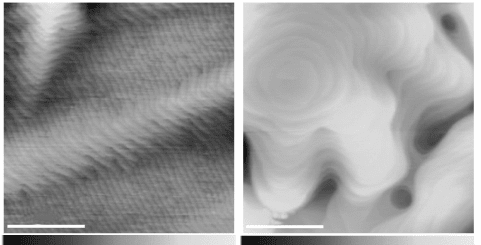
302 Thin film growth
© Woodhead Publishing Limited, 2011
a 10 mm ¥ 10 mm area. This surface morphology is very similar to that of
homoepitaxial GaN grown by MBE on MOVPE-grown GaN.
on the other
hand, grain-like morphology with step-ow features within each grain is
observed in n-polar samples. The step height is usually 2 ML or multiple
MLs.
Thus, it is better to grow InN epilayers under In-polarity in order to achieve
an atomically at surface. In addition, it was observed that the following
factors are necessary: (1) the growth temperature should be as high as possible;
(2) growth should be kept under slightly In-rich conditions; and (3) keeping
the screw-component threading dislocation as low as possible. It should be
noted here that it is impossible to avoid the formation of in droplets to get
a at surface at such low temperatures as we mentioned above. However, a
regular growth interruption under N beam irradiation can be used to eliminate
the in droplets, though one should carefully control the irradiation time since
longer irradiation is found to result in a rough surface.
The control of polarity for inn is basically achieved by using gan buffer
layers with controlled polarity. The reason is that the lattice matched substrate
for inn is not available and sapphire is the most popular substrate in inn
epitaxy. Since the lattice mismatch between InN and sapphire is very big
(~25%), gan is usually used as a buffer layer or template for inn epitaxy,
which shows better crystalline quality than the InN layer grown on sapphire
by only using low temperature InN buffer layer (Chen et al., 2006). Then, the
In- and N-polarity InN layers are grown on Ga- and N-polarity GaN buffer
layer/template. For the Ga-polar layer/template, either MOVPE-grown GaN
epilayer or MBE-grown GaN/AlN double buffer layers can work well (Heying
et al., 1999; Ide et al., 2003). As for the N-polar GaN layer, it is grown on
GaN buffer layer using nitridation process by MBE as we discussed in the
last section.
In-polarity N-polarity
1 µm 1 µm
0.00 [nm] 4.03 0.00 [nm] 19.34
12.12 AfM images of surface morphology of InN at In- and
N-polarities, respectively.
ThinFilm-Zexian-12.indd 302 7/1/11 9:44:17 AM

303Polarity controlled epitaxy of III-nitrides and ZnO
© Woodhead Publishing Limited, 2011
A summary of MBE-grown high quality and high purity InN epilayers
under different polarities is shown in Table 12.2. The In-polar samples are
grown on 3.7 mm thick MOVPE-grown GaN templates and the N-polar
samples are grown by the whole MBE process on the 500 nm thick N-polar
GaN epilayers. The N-polar samples show better crystalline structural quality,
which is due to the higher maximum epitaxial temperature. The N-polarity
growth is preferable from the viewpoint of better matching with epitaxy
temperatures among other III-nitrides. From the viewpoints of surface atness
and sharp interface, however, In-polarity is denitely a better choice. As
shown in Table 12.2, the lowest n
e
is at 10
17
cm
–3
levels for both polarities,
where the In-polar samples show a little lower residual electron density
and higher mobility. although the residual donor levels are still high, the
data imply that the extrinsic donor impurities in the inn layers are pretty
low considering the contribution from high density edge-type threading
dislocations.
it is important to investigate the origin of fairly high residual electron
concentration in InN. Since the Fermi stabilization energy is located in
the conduction band for inn, unintentionally doped impurities and native
defects tend to be ‘shallow’ donors. It is believed that the nitrogen vacancy
would be a major native defect due to the lowest formation energy among
native defects. in addition, oxygen and hydrogen are also expected to
be a signicant source of free electrons in InN. Thus, the growth should
be performed under growth chamber conditions as pure as possible and
under controlled surface stoichiometry as well. Furthermore, the edge-type
threading dislocations (ETDs) should be reduced to as low as possible. It
has been found that this type of threading dislocation is the dominant one
in the InN layer which basically originates from large lattice mist with the
substrate. Its density is about 1–2 orders higher than that of the screw-type
one. It is known that the edge-type threading dislocations in GaN introduce
deep levels in the forbidden band. However, it was theoretically conrmed
that they generate donor levels above the conduction band bottom in inn,
Table 12.2 Comparison of MbE grown In-polarity and N-polarity InN epilayers
In-polarity InN N-polarity InN
Growth temperature Less than ~500°C Less than ~600°C
Surface flatness/
morphology
Atomically flat, monolayer
steps
Columnar/grain-like rough,
bilayer steps
XRd-fWhM (002) 200–540 arcsec 200–250 arcsec
XRd-fWhM (102) 800–1100 arcsec 1000–650 arcsec
Residual electron density
at RT
2–30 ¥ 10
17
cm
–3
4–50 ¥ 10
17
cm
–3
Electron mobility at RT 1500–2200 cm
2
/Vs 1500–2150 cm
2
/Vs
ThinFilm-Zexian-12.indd 303 7/1/11 9:44:17 AM
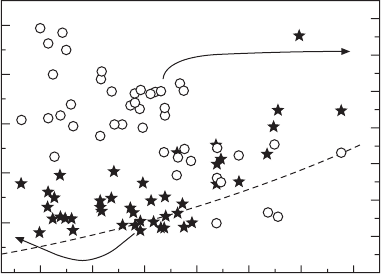
304 Thin film growth
© Woodhead Publishing Limited, 2011
though their exact levels are slightly different depending on their detailed
core structures (Takei and Nakayama, 2009). Then it is considered that
the edge-type threading dislocation is one of residual donor species in inn
when the residual impurities and point defects are reduced below 10
17
cm
–3
levels. This is also conrmed by experimental observation as shown in Fig.
12.13, where the electron concentrations (n
e
) and mobilities (m
e
) of dozens
of In-polar InN lms with thicknesses of 0.5–5 mm are shown as a function
of full width at half maximum (FWHM) measurements of (102) InN w
scans. These n
e
’s are net for the bulk, i.e, the surface/interface charges of
3–5 ¥ 10
13
cm
–2
has been removed.
As shown in Fig. 12.13, n
e
increases from 4.0 ¥ 10
17
to 2.4 ¥ 10
18
cm
–3
with
increasing FWhM
(102)
from 950 to 2200 arcsec, indicating the increase of
n
e
with increasing ETD density since the FWHM
(102)
is correlated with the
ETDs. The dashed line indicates the contribution of dangling bonds to the
n
e
in the inn epilayers, assuming that each dangling bond at the ETDs acts
as a singly ionizable donor, i.e., two electrons are supplied every monolayer
along each ETD. It is shown that the dependence of the dashed line agrees
well with that of the n
e
on FWhM
(102)
and even the values are almost
exactly the same as the experimental data too. This conrms the theoretical
prediction that ETDs act as donors and are probably a dominant source of
n
e
in high purity InN epilayers. The discrepancy between the measured n
e
and the density of dangling bonds is probably caused by the contributions
from impurity- and point-defects-generated carrier concentrations not being
taken into account. in addition, m
e
decreases from 2150 to 1000 cm
2
/Vs with
increasing FWhM
(102)
from 950 to 2200 arcsec, showing that the m
e
is also
inuenced by the ETDs.
Electron concentration (cm
–3
)
hall mobility (cm
2
/Vs)
2.5 ¥ 1 0
18
2.0 ¥ 1 0
18
1.5 ¥ 1 0
18
1.0 ¥ 1 0
18
5.0 ¥ 1 0
17
0.0
1000 1200 1400 1600 1800 2000 2200
fWhM of (102) w scans (arcsec)
2200
2000
1800
1600
1400
1200
1000
800
12.13 Electron concentrations and hall mobilities of many InN films
as a function of fWhMs of (102) w scans. The estimated density of
dangling bonds originating from edge-type threading dislocations is
shown by the dashed line.
ThinFilm-Zexian-12.indd 304 7/1/11 9:44:18 AM
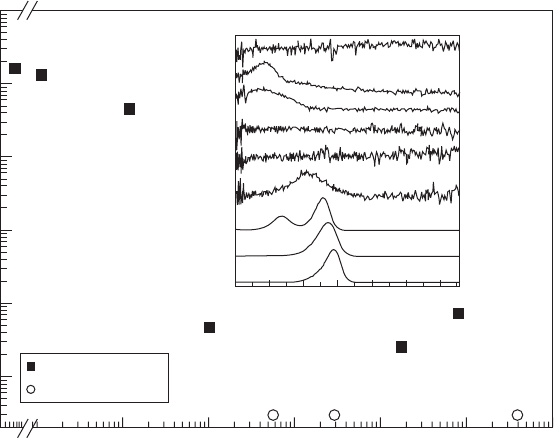
305Polarity controlled epitaxy of III-nitrides and ZnO
© Woodhead Publishing Limited, 2011
P-type doping is one of the most important topics. although the residual
donor levels are still fairly high, it is considered that extrinsic donor impurity
levels are almost low enough to try p-type doping. Mg is a popular and
effective dopant in p-type doping of gan and aln, and it is also the most
studied one in InN. It was found that the effects of Mg doping on properties
of InN with different polarities are very similar (Wang et al., 2007a). The
sticking coefcient of Mg on In-polarity InN is almost unity, which is
probably attributed to the growth temperature being low and thus Mg is
effectively adsorbed and incorporated into inn. The Mg concentrations for
the N-polarity InN at the same Mg beam ux are almost the same as those
for the In-polarity case, indicating that the Mg sticking coefcient in InN is
independent of polarity.
An important factor in evaluating the doping difculty is the activation
energy of Mg acceptors. To evaluate it, photoluminescence (PL) properties
of Mg-doped InN are investigated. Figure 12.14 shows PL spectra and
corresponding PL intensity measured at 16 K as a function of [Mg]. It is
shown that PL intensity changes in more than ve orders of magnitude. At
[Mg] ~ 10
18
cm
–3
, the intensity is already lower by about four orders in
magnitude than that of the undoped one, and no PL emission is detected at
[Mg] ~5.6–29 ¥ 10
18
cm
–3
, where it is proven to be p-type region as shown
PL intensity (a.u.)
10
5
10
4
10
3
10
2
10
1
10
0
PL intensity
No detectable PL
10
16
10
17
10
18
10
19
10
20
10
21
10
22
Mg concentration (cm
–3
)
0.55 0.60 0.65 0.70 0.75 0.80 0.85
E (eV)
PL (a.u.)
[Mg]: cm
–3
3.9 ¥ 1 0
21
8.0 ¥ 1 0
20
1.8 ¥ 1 0
20
2.9 ¥ 1 0
19
5.6 ¥ 1 0
18
1.1 ¥ 1 0
18
1.3 ¥ 1 0
17
1.2 ¥ 1 0
16
Undoped
12.14 PL intensity and PL spectra (inset) of InN layers at 16 K as a
function of Mg concentrations.
ThinFilm-Zexian-12.indd 305 7/1/11 9:44:18 AM
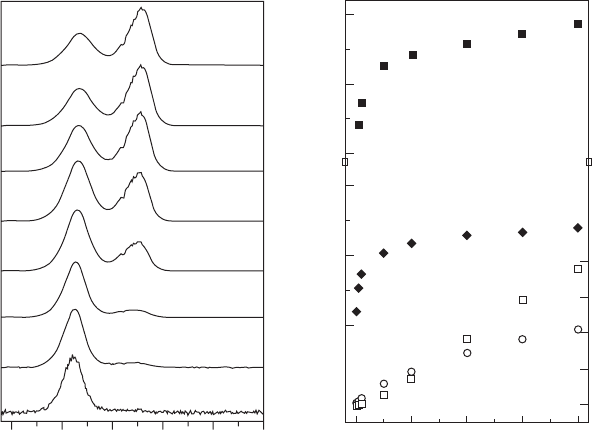
306 Thin film growth
© Woodhead Publishing Limited, 2011
later. Weak PL emission is observed again with increasing [Mg]. Further,
no PL emission can be detected at [Mg] ~3.9 ¥ 10
21
cm
–3
again, which is
probably because of unknown luminescence-killer processes in these poor
quality samples. The exact reason for weak emission in InN:Mg at [Mg]
~5.6–29 ¥ 10
18
cm
–3
as well as p-type InN reported later are not currently
clear, but one possible reason is the long diffusion length of minority carriers
(electrons) in p-InN resulting in their easy annihilation at killer defects and/
or the introduction of high-density complex defect levels by Mg-overdoping
resulting in about ve orders of magnitude higher carrier relaxation paths.
In the InN:Mg sample at [Mg] ~1.3 ¥ 10
17
cm
–3
, two emission peaks are
clearly observed at around 0.67 (labelled as I
bb
in Fig. 12.15) and 0.61
(I
fa
) eV, respectively. Excitation power dependent PL study of this sample
is shown in Fig. 12.15. It is clear that intensity of I
bb
is linearly increased
with increasing excitation power while that of I
fa
tends to be saturated. This
indicates that I
bb
originates from the band-to-band transitions while I
fa
comes
from the free-to-acceptor transitions, where the activation energy for Mg
acceptors is estimated to be about 61 meV.
The observation of such shallow Mg acceptor levels implies that the
PL intensity (a.u.)
PL intensity (a.u.)
Photon energy (eV)
0.55 0.60 0.65 0.70 0.75 0.80
Photon energy (eV)
(a)
0 10 20 30 40
Excitation power (mW)
(b)
I
fa
I
bb
40 mW
30 mW
20 mW
10 mW
5 mW
1 mW
0.5 mw
0.1 mW
I
bb
I
bb
I
fa
I
fa
0.680
0.675
0.670
0.620
0.615
0.610
4
3
2
1
0
12.15 (a) 16 K PL spectra of partly compensated InN:Mg under
different excitation powers. (b) Intensity and energy of I
fa
(free to
acceptor recombination) and I
bb
(band to band) as a function of
excitation power.
ThinFilm-Zexian-12.indd 306 7/1/11 9:44:18 AM
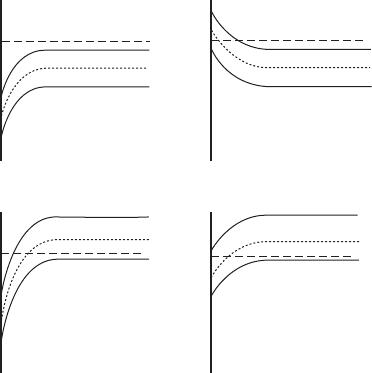
307Polarity controlled epitaxy of III-nitrides and ZnO
© Woodhead Publishing Limited, 2011
p-type doping may not be as difcult as we imagined previously. It seems
that the problem of how to detect the p-type conduction is more serious
at this moment. The p-type conduction has not been directly conrmed
by conventional hall effect measurements. This is due to the existence of
surface electrons as well as the interface accumulation layer with an electron
density of 3–5 ¥ 10
13
cm
–2
, which is independent of bulk layer conductivity
(Mahboob et al., 2004). Therefore, the most commonly used method to
detect p-type conduction is currently electrolyte-based capacitance voltage
(ECV) and thermal power (Jones et al., 2006; Yim et al., 2007; Wang et
al., 2007a).
ECV measurements are usually performed by using an electrolyte, for
example KOH or NaOH solutions, to form a Helmholtz-layer contact on InN.
This Helmholtz layer behaves as a very thin insulator and the total structure
is like a ‘metal-insulator-semiconductor (MIS) structure’ in principle. To
successfully modulate the surface Fermi level, the electric eld intensity in the
Helmholtz layer must be strong enough to deplete the surface electrons. The
principle of how to detect the buried p-type region under high density surface
electron is shown in Fig. 12.16. As shown in Fig. 12.16(a), the surface Fermi
level in inn is located inside the conduction band due to high-density surface
electrons. since the inn is highly conductive in this case, the situation for
V
bias
= 0
n-type InN
p-type InN p-type InN
n-type InN
(a)
(c) (d)
(b)
E
f
E
C
E
C
E
C
E
f
E
f
E
f
E
C
E
V
E
V
E
V
E
V
V
bias
@C
mini
(=V
peak
)
12.16 Energy band diagram for ECV characterization on detecting
the conduction type of bulk InN region located below high-density
surface electrons. The vertical thick lines indicate the helmholtz layer
in the electrolyte. (a) and (c) are for the zero bias voltage for n-type
and p-type samples, respectively. Correspondingly, (b) and (d) are for
those under voltage biased for detecting the minimum capacitance.
ThinFilm-Zexian-12.indd 307 7/1/11 9:44:19 AM
